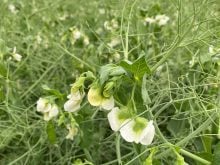Tom Borgen, who farms near Langdon, North Dakota, remembers what it was like 20 years ago when he had a canola pest problem and needed a chemical solution.
“There was nothing,” Borgen said at a pesticide standardization session during the Northern Plains Producer Conference held in Winnipeg on Nov. 14-15.
“Now we have two or three chemicals for each pest that we have in canola, thanks to harmonization and joint review efforts.”
That’s why Borgen was doing something that few farmers do at conferences – praising government officials for making farmers’ lives better.
Read Also

Crop quality looks good this year across Prairies
Crop quality looks real good this year, with the exception of durum.
“They’ve been good for me as a grower,” he said about the Canadian Pest Management Regulatory Agency and the U.S. Food and Drug Administration.
Officials at both the PMRA and FDA have been trying to standardize chemical regulations so farmers in each country have access to the same crop treatments.
They have begun approving new chemicals that are jointly submitted to both countries, and are encouraging manufacturers to keep the approvals consistent in Canada and the United States. If chemicals are approved in one country but not the other, not only are growers in one country at a disadvantage, but the situation can blow up into a trade dispute.
Problems have arisen when chemical manufacturers apply for approval in one country but not in the other.
Pesticide standardization has been a simmering issue for farmers of most crops for many years, but has been most prominent in the canola industry.
Most other crops have large acreages in both Canada and the United States, which encourages manufacturers to license at least some products in both countries.
But it’s been a different story for canola. Since there’s only a tiny canola acreage in the U.S., and manufacturers can only seek a restricted number of approvals per year, canola products have been rare.
That left American growers with virtually no chemical control options for years, and they still have fewer options than Canadian farmers a few kilometres north.
This was also a problem for Canadian farmers, because some American states threatened to block shipments of Canadian grain and livestock that were treated with products not approved in the U.S.
As part of the North American Free Trade Agreement, chemical regulators on both sides of the border are trying to standardize their regulations and are accepting joint submissions.
It’s something Borgen, who founded the Northern Canola Growers of North Dakota, jumped into with gusto.
“In two months I must have flown 45,000 miles,” said Borgen about the trips he took to convince chemical manufacturers to make joint submissions, rather than seek Canada-only approvals.
“I think we convinced the chemical companies that trade irritants can kill industries,” he said. “They wouldn’t only lose the American (canola) industry, but they could lose the Canadian one too if they couldn’t ship their products.”
When asked by a farmer how to more quickly get more chemicals jointly approved, the PMRA’s Wendy Sexsmith said farmers should pressure chemical companies to make joint submissions. Canadian and American officials are keen to accept them.
“We want a North American market for pesticides,” said Sexsmith, the PMRA’s director of alternative strategies and regulatory affairs.
“We’re convinced there are huge benefits to working together.”
Borgen said his admiration for the PMRA and EPA arose after he saw how hard the two agencies worked to achieve standardization.
Once the canola industry let regulators know what it wanted, government officials started sorting out the problems.
Borgen said the successes in canola can work for other crops.

















